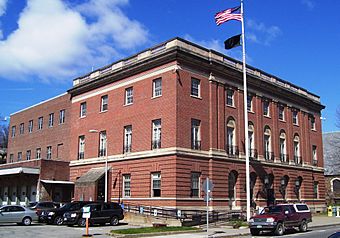Brattleboro Downtown Historic District facts for kids
|
Brattleboro Downtown Historic District
|
|

Post office and courthouse
|
|
| Lua error in Module:Location_map at line 420: attempt to index field 'wikibase' (a nil value). | |
| Location | Main St. from Vernon to Walnut, Flat, Elliot, High, and Grove Sts., Plaza Park, Brattleboro, Vermont |
|---|---|
| Area | 22 acres (8.9 ha) (original) 1 acre (0.40 ha) (increase) |
| Built | 1840 |
| Architectural style | Greek Revival, Georgian |
| NRHP reference No. | 83003225 (original) 04000982 (increase) |
Quick facts for kids Significant dates |
|
| Added to NRHP | February 17, 1983 |
| Boundary increase | September 15, 2004 |
The Brattleboro Downtown Historic District is a special area in Brattleboro, Vermont. It's like a time capsule showing how the town's main business area grew. This district includes many important buildings along Main Street, from old shops to public offices. Most of these buildings were built in the 1800s, but some are even older or from the early 1900s. This historic area was officially recognized and added to the National Register of Historic Places in 1983. Later, in 2004, it was made a bit bigger to include Plaza Park and the Holstein Building.
Contents
Discovering Downtown Brattleboro's History
How Brattleboro's Downtown Grew
Brattleboro started as a town way back in 1753. It was settled in the 1760s. The town center you see today grew around mills built on Whetstone Brook. In 1804, a bridge was built over the nearby Connecticut River. This made it easier for people to travel and trade with places to the east.
In 1811, the first paper mill opened on Whetstone Brook. This started important industries that became a big part of Brattleboro's economy. When the railroad arrived in 1849, it brought even more growth and business to the town.
Key Moments in Brattleboro's Development
After a big flood in 1869 and fires in 1869 and 1877, many new buildings were constructed downtown. This period of building lasted until about 1910. These new buildings gave the area much of its look and feel that we see today.
Exploring the Historic District's Layout
The Brattleboro Downtown Historic District starts at its northern end where Main, Linden, and Walnut Streets meet Pultney Road. Near this spot, you'll find the Wells Fountain, built in 1890. It stands like a marker for the top of the business district.
The district then stretches south along Main Street. A few properties on side streets that go west are also part of it. It ends at the intersection of Bridge, Canal, and Vernon Streets, just south of Whetstone Brook.
Special Spots in the District
This southern intersection features Plaza Park, which was created in 1923. A central part of the park is a copy of the Spirit of Life statue by Daniel Chester French.
Only a couple of buildings south of Whetstone Brook are included in the district. One is the old railroad station, which is now the Brattleboro Museum and Art Center. The other is the Holstein Association Building, with its oldest part dating back to 1917.
Along Main Street, you'll see other important buildings. These include the former Brooks House Hotel. This hotel is a great example of the Second Empire style, designed by Vermont native Elbridge Boyden.

